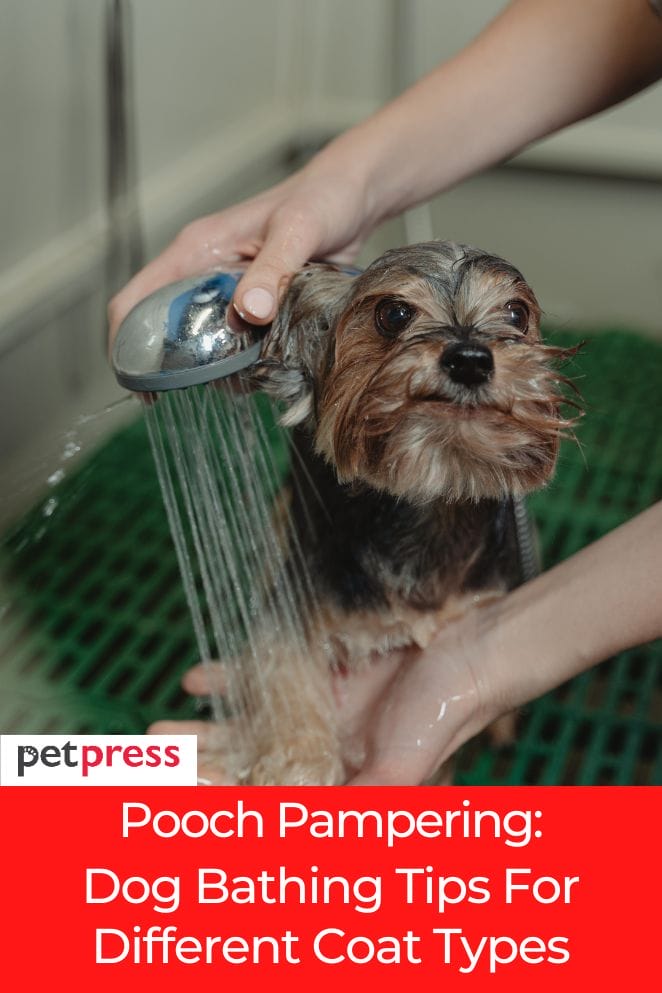
Dogs are beloved members of our families, and keeping them clean and healthy is a top priority.
Bathing your dog is an essential part of their grooming routine, but it’s crucial to understand that different coat types require specific care.
In this blog post, we’ll explore the importance of proper dog bathing, common dog coat types, and tailored tips for each coat type.
Importance of Proper Dog Bathing
Proper dog bathing isn’t just about a quick rinse – it’s a cornerstone of responsible pet care.
Let’s delve into why it’s so crucial and explore the numerous benefits it brings to your furry friend’s life.
Improved health
Think of bathing as a spa day for your pup. It’s not just about making them smell better; it’s about keeping them healthy from the outside in.
Regular baths wash away dirt, grime, and allergens that can cling to their fur.
This reduces the likelihood of skin irritation and infections, helping your dog feel more comfortable in their own skin.
Cleanliness
Have you ever hugged your dog only to recoil from their not-so-fresh scent?
Regular bathing keeps your dog’s coat clean and smells delightful.
Not only does this benefit your dog’s comfort, but it also contributes to a cleaner, fresher-smelling home environment.
Skin care
Just like humans, dogs can suffer from clogged pores and skin irritation.
Bathing helps prevent these issues by keeping their skin clean and free from debris.
By reducing inflammation and irritation, regular baths promote healthy skin, ensuring your dog feels their best.
Reduced shedding
Shedding can be a nightmare for pet owners, especially those with allergies.
Regular bathing, coupled with routine brushing, can significantly reduce your dog’s shedding.
By removing loose fur and preventing mats, you’ll keep your home cleaner and more comfortable for everyone.
Bonding time
Bathing isn’t just about hygiene – it’s also an opportunity for quality bonding time with your furry companion.
The gentle act of washing your dog provides a chance for affectionate interaction, strengthening the bond between you and your pet.
Plus, many dogs enjoy the attention and physical contact, making bath time a positive experience for both of you.
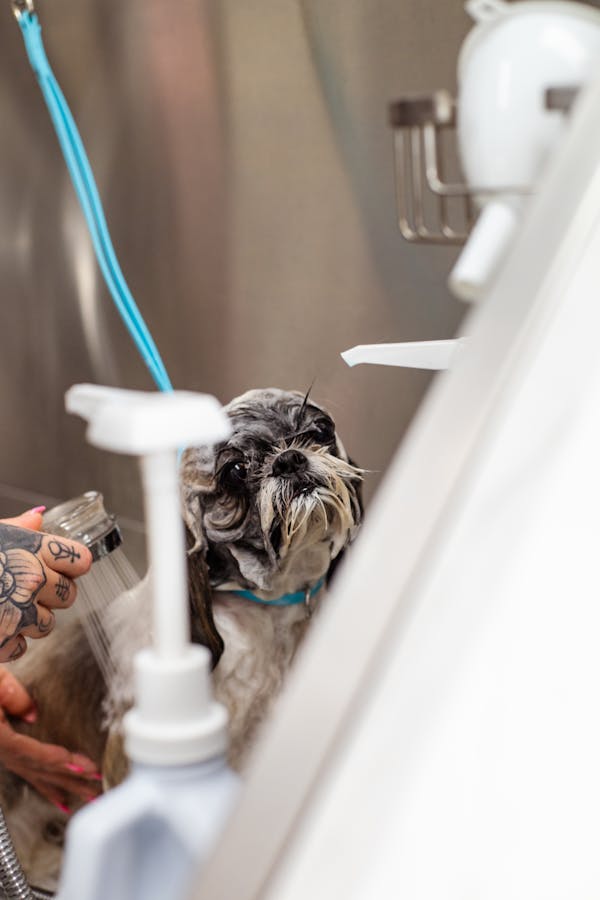
Common Dog Coat Types
Let’s talk about different types of dog coats.
Knowing your pup’s coat type can help you choose the right shampoo and grooming routine.
- Smooth & short: These dogs have sleek coats that are easy to maintain. A gentle shampoo and a quick rinse are usually all they need.
- Long & silky: Think of breeds like the Afghan Hound or the Yorkshire Terrier. These dogs require regular brushing to prevent tangles and mats.
- Double coat (coarse & soft): Their double-layered coats provide extra insulation but also require extra care.
- Curly & wavy: Poodles and Bichon Frises are examples of dogs with curly or wavy coats. These breeds often need professional grooming to keep their curls in check.
- Wirehaired: Breeds like the Wire Fox Terrier have coarse, wiry fur that needs regular stripping to remove dead hair.
Bath Time Basics for All Coats
Bathing your dog is a bit of an art form, but with the right supplies and technique, it becomes a breeze.
Let’s break down the basics of bath time for all types of coats, from smooth to curly.
Gathering supplies
Before you begin, gather everything you need.
Make sure you have dog-specific shampoo and conditioner – human products can irritate your pup’s skin.
You’ll also need brushes suited to your dog’s coat type, along with washcloths, towels, and a dog dryer if you have one.
And don’t forget the warm water – it should be comfortably warm, not hot, to avoid scaring or burning your furry friend.
Pre-bath brushing
Start by giving your dog a good brushing.
This step is crucial for removing loose hair and mats, ensuring a thorough clean and preventing tangles during the bath.
Plus, it’s a great way to bond with your pup before the water comes into play.
Bath time steps
Now that your supplies are ready and your dog is brushed, it’s time to get down to business.
- Gently wet the dog down: Use lukewarm water to wet your dog’s coat, avoiding their ears and eyes.
- Lather with shampoo: Apply a small amount of dog shampoo to your hands and work up a gentle lather. Focus on areas that tend to get dirty easily, like the belly, paws, and rear end.
- Apply conditioner: If your dog’s coat could use a little extra love, consider using a conditioner specific to their needs.
- Rinse thoroughly: Use lukewarm water to rinse away all traces of shampoo and conditioner, making sure to get every nook and cranny.
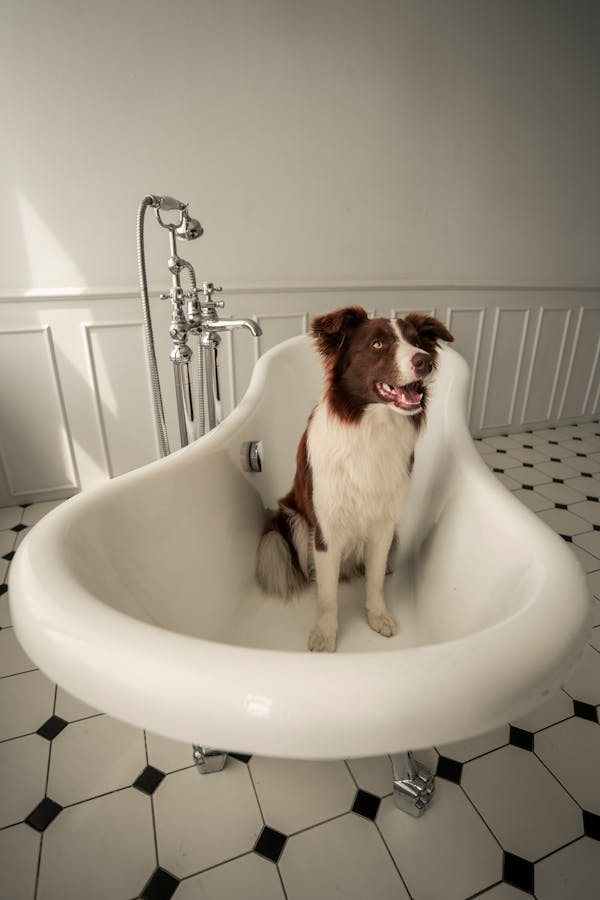
Tips for Different Coats
Each dog’s coat is unique, and understanding how to care for different types can make a world of difference in their appearance and overall health.
Let’s explore some tips tailored to various coat types, from smooth and short to curly and wire-haired.
Smooth & short
- Bathing frequency: Dogs with smooth and short coats typically don’t need frequent baths – every 4-8 weeks or as needed should suffice.
- Special considerations: If shedding is a concern, opt for a de-shedding shampoo to help reduce loose fur.
- Drying: Due to their short fur, drying is usually quick and straightforward. A thorough towel drying is often sufficient to get them dry and cozy.
Long & silky
- Bathing frequency: Dogs with long and silky coats benefit from more frequent baths – aim for every 3-4 weeks to keep their fur in top condition.
- Special considerations: Use a gentle shampoo and conditioner specifically formulated for long coats to prevent matting and tangles.
- Brushing: Before and after bathing, give their coat a thorough brushing to remove any knots or mats and to distribute natural oils for a healthy shine.
- Leave-in conditioner: Consider using a leave-in conditioner to enhance shine and manageability, especially for breeds with extra-long locks.
Double coat (coarse & soft)
- Bathing frequency: Double-coated breeds like to keep their natural oils intact, so aim for baths every 6-12 weeks to avoid over-bathing.
- Special considerations: Use a shampoo formulated for double coats to effectively penetrate the dense undercoat while still being gentle on the skin.
- Brushing: Regular brushing before and after bathing helps remove loose undercoat fur and prevents matting.
- Conditioning: Consider using a conditioner specifically designed for the coarse outer coat to keep it soft and healthy.
Curly & wavy
- Bathing frequency: Dogs with curly or wavy coats typically benefit from baths every 3-6 weeks to keep their curls looking their best.
- Special considerations: Opt for a moisturizing shampoo and conditioner to prevent dryness and maintain curl definition.
- Rinsing technique: Scrunching the coat gently while rinsing helps preserve the curl pattern and prevent frizz.
- Drying: Air-drying is ideal for curly coats, but if you’re using a dryer, attach a diffuser to prevent disrupting the curls.
Wirehaired
- Bathing frequency: Wirehaired breeds can go longer between baths – aim for every 3-4 months to avoid stripping away natural oils.
- Special considerations: Some wirehaired breeds may require stripping, a process best left to professional groomers to maintain the coat’s texture.
- Shampoo selection: Use a mild shampoo that won’t strip away the coat’s wiry texture, and avoid conditioners that can soften the fur.
- Drying: Towel dry thoroughly to maintain the wiry texture of the coat and prevent any matting or tangling.
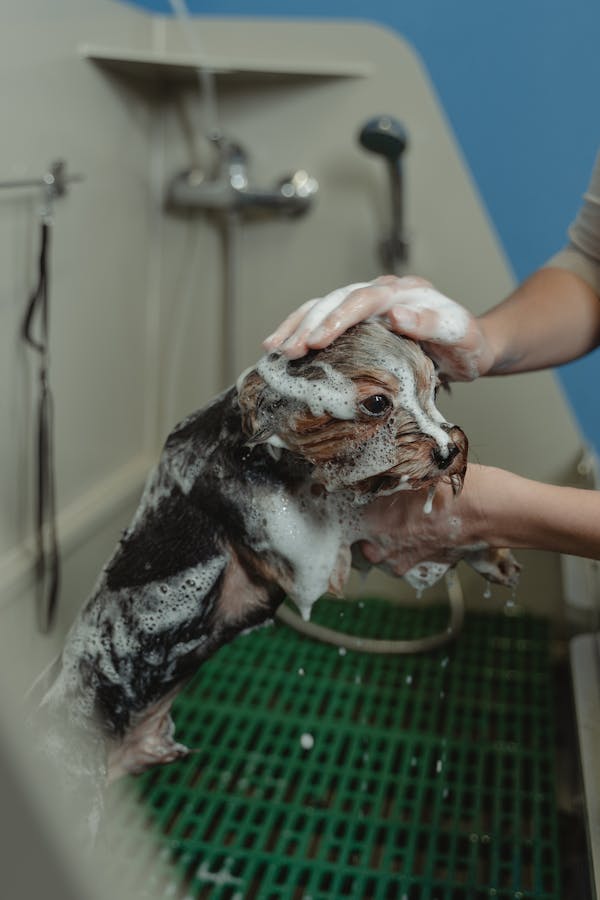
Post-Bath Pampering
Once the bath is done, it’s time for some post-bath pampering to ensure your dog feels fresh and fabulous.
Let’s dive into the details of each step:
Towel drying and gentle brushing
After your dog’s bath, grab a fluffy towel and gently pat them dry.
Avoid rubbing vigorously, as this can cause tangles or irritation to their skin.
Instead, softly blot the fur to absorb excess water. If your pup has a long or thick coat, consider using a blow dryer on a low setting to speed up the drying process.
Ear cleaning
However, it’s essential to consult your vet for proper ear-cleaning techniques, as improper cleaning can lead to irritation or injury.
If your vet gives the green light, use a damp cotton ball or a gentle ear-cleaning solution specifically formulated for dogs.
Gently wipe the visible parts of the ear, avoiding the ear canal to prevent pushing debris further in.
Nail trimming
If your dog’s nails have gotten a bit long, post-bath time is the perfect opportunity for a trim.
Use pet-specific nail clippers and be cautious not to cut too close to the quick, which can cause bleeding and discomfort.
If you’re unsure about how to trim your dog’s nails safely, consult your vet or a professional groomer for guidance..
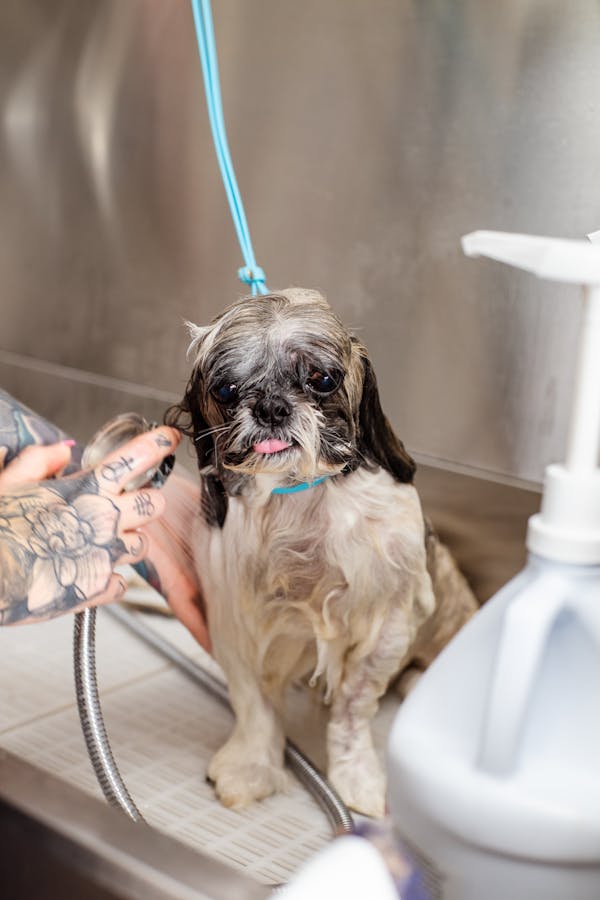
Conclusion
Understanding your dog’s coat type and its unique needs is essential for maintaining their health and appearance.
Regular bathing, using appropriate products, and proper grooming techniques can make all the difference.
Remember, every dog is unique, so tailor your bathing routine to their specific needs.
FAQs
The frequency depends on the coat type. Smooth and short coats may need bathing every 4-8 weeks, while wirehaired breeds can go up to 3-4 months between baths.
No, always use dog-specific shampoo and conditioner to avoid irritation and potential health issues.
Use a detangling shampoo and brush gently to remove mats. If they are too tight, consult a professional groomer.
Yes, but use a dog hairdryer with a diffuser attachment to avoid overheating and damaging the coat.
Towel drying and gentle brushing can help remove excess water and prevent matting, reducing the need for shaking.


GIPHY App Key not set. Please check settings